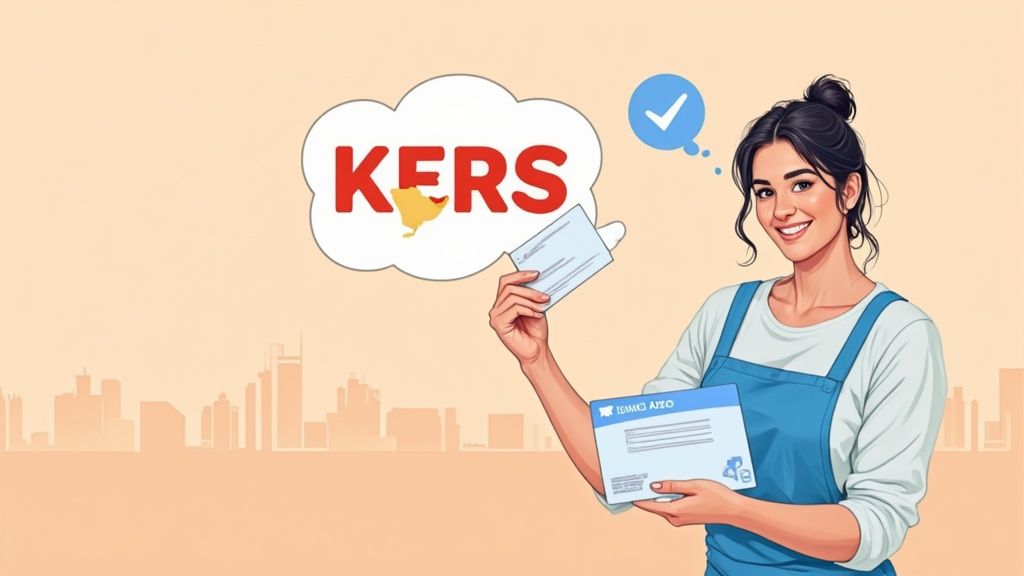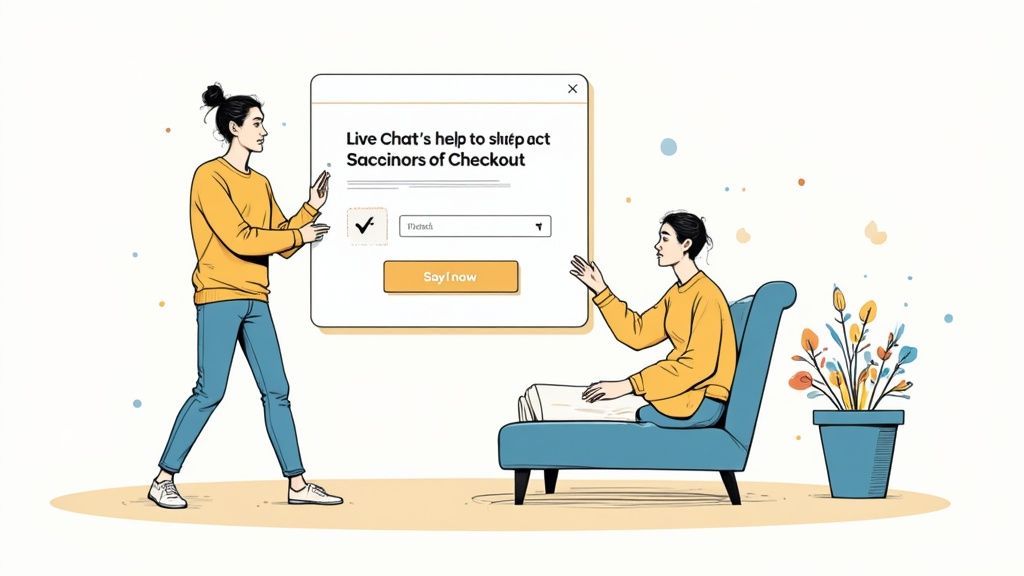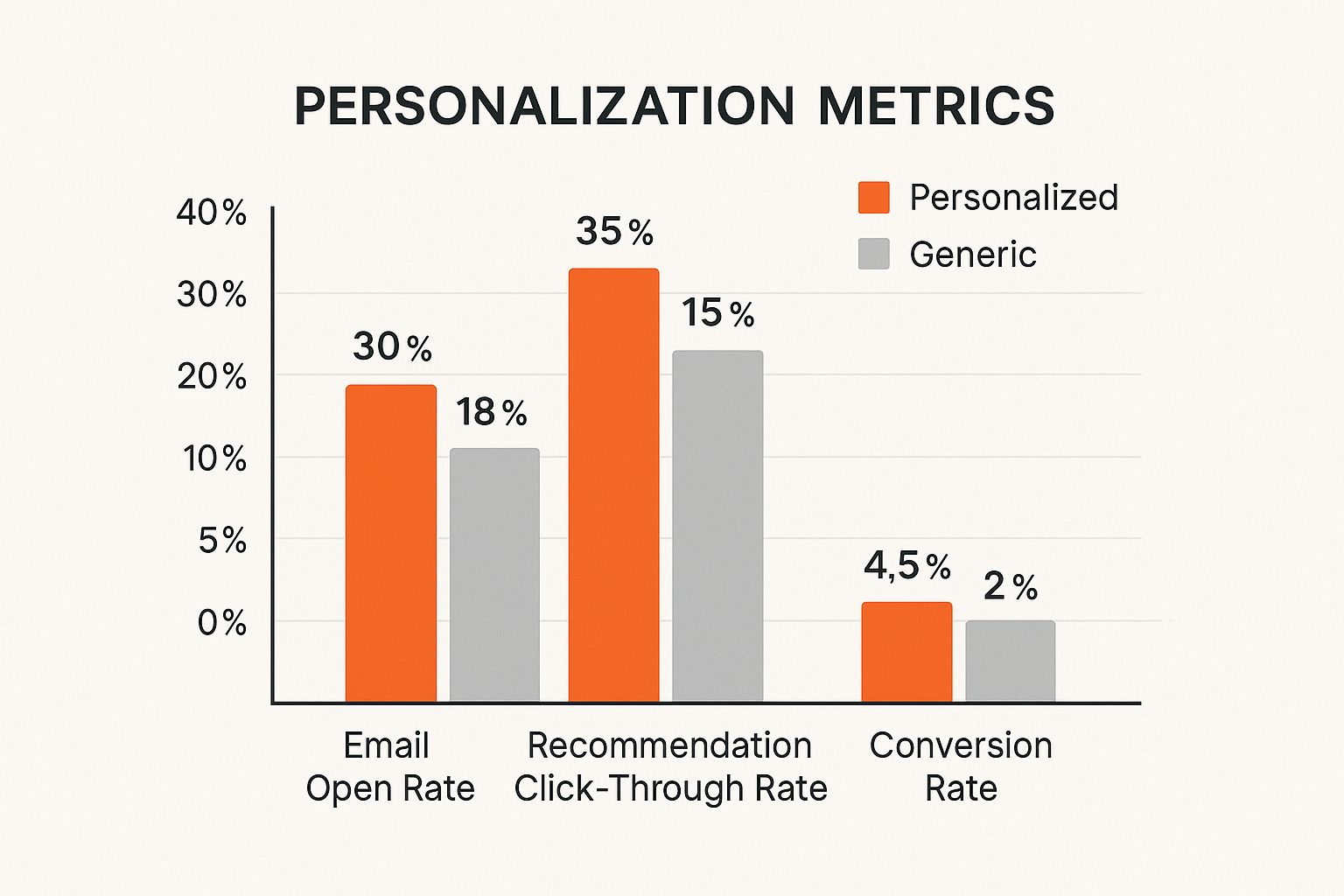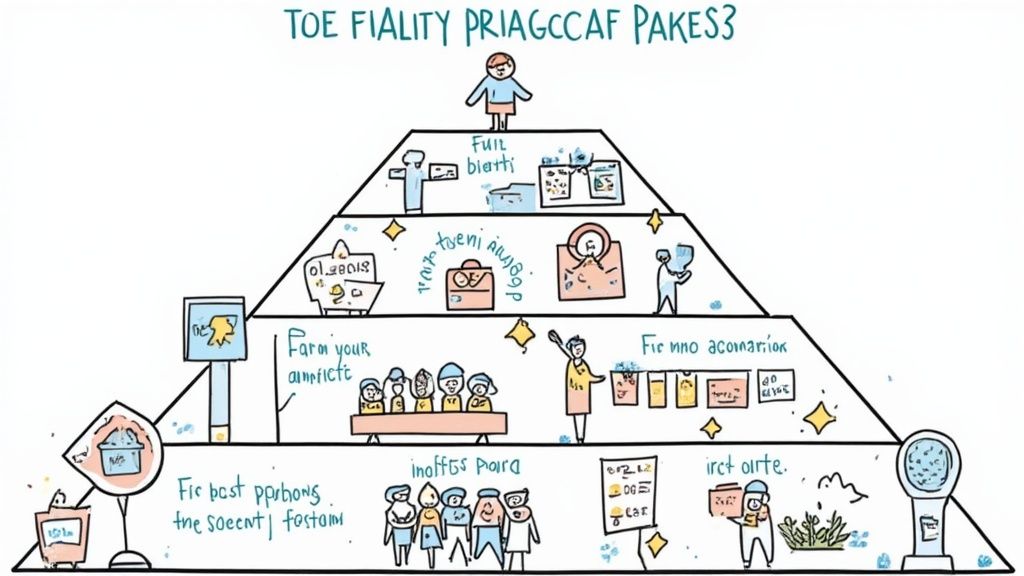How to Improve Customer Satisfaction
When we talk about improving customer satisfaction, we're really talking about playing the long game. It's not just about making someone happy with a single purchase; it's about building genuine, lasting loyalty. This means shifting your mindset from putting out fires to proactively delighting your customers, using data to create truly personal experiences, and building feedback systems that actually lead to change. The ultimate prize? Turning those happy customers into your most passionate brand advocates.
Going Beyond Satisfaction to Earn Real Loyalty

It’s easy for e-commerce brands to see a high customer satisfaction (CSAT) score and pat themselves on the back. But here’s the hard truth: a satisfied customer isn't necessarily a loyal one. Satisfaction is often just a fleeting feeling tied to a single, smooth transaction. Loyalty, on the other hand, is built over time and runs much deeper.
A loyal customer will stick with you even if a competitor dangles a slightly better deal. They’re more likely to forgive a small hiccup, rave about you to their friends, and give you the kind of honest feedback that helps you grow. This difference is more important now than ever. Global studies show a worrying trend: even as satisfaction scores hold steady, key loyalty metrics like trust and repurchase intent are dropping.
From Happy Shoppers to Brand Advocates
Your real mission is to convert those one-time happy shoppers into true brand advocates. This takes a lot more than just closing out support tickets efficiently. It's about forging an emotional connection and making every customer feel like they genuinely matter to your brand.
Here’s where you can start making a real impact:
- Be Proactive, Not Reactive: Try to anticipate your customers' needs. For instance, if you know a shipment is delayed, don't wait for the angry email. Send a notification first, explain the situation, and offer a sincere apology. That small act builds immense trust.
- Get Personal (In a Good Way): Use the data you have to create experiences that feel unique to each person. A simple product recommendation based on their past purchases shows you're paying attention.
- Make Feedback Count: It’s not enough to just ask for feedback. You have to visibly act on it. When customers see their suggestions leading to real changes, they feel heard and valued.
The path from a single happy purchase to lifelong advocacy is paved with trust and consistently positive experiences. Every single touchpoint is a chance to make that relationship stronger.
To really get this right, you need to become a master of customer experience optimization, making sure every interaction is as smooth and memorable as possible. If you're ready to build those unbreakable customer bonds, digging into proven strategies to increase customer retention is the perfect next step.
Shifting to Proactive Customer Service

For years, the standard customer service playbook was simple: wait for a problem, then solve it. While you'll always need to be good at reacting, relying solely on that model means you're always playing catch-up. The brands that truly stand out don't just solve problems—they get ahead of them.
Moving to a proactive mindset is one of the most powerful levers you can pull to boost customer satisfaction. It’s about changing your support from a simple ticket-answering machine into an intelligent, problem-solving partner for your customers. You start anticipating what they’ll need and offering solutions before they even think to ask. This simple shift makes their lives easier and builds a deep sense of trust.
This isn't just a "nice-to-have" anymore; it's essential. Customer expectations are sky-high. In fact, 99% of consumers say customer service is a key factor in their buying decisions, and 74% consider it critical. When the stakes are that high, getting proactive gives you a massive competitive edge. For more on this, check out these customer experience statistics on Webex.com.
Empowering Customers with Self-Service
One of the best ways to be proactive is to empower customers to help themselves. A well-organized, easy-to-search knowledge base or FAQ section is an absolute must. This isn't just about cutting down on support tickets; it's about respecting your customers' time.
Think about it. When someone can find the details of your return policy at 11 PM without having to wait for a reply, you’ve just delivered a great experience. Your knowledge base should be a living resource, constantly updated with the real questions your support team is hearing every day.
Anticipating Needs with Smart Triggers
You can use technology to spot potential roadblocks in the customer journey and offer help right when it's needed most. Smart triggers on your website are a perfect example.
Here are a few ways I’ve seen this work incredibly well:
- Checkout Hesitation: A customer has been on the checkout page for over a minute. A small chat window pops up: "Have any questions about your order? I'm here to help!"
- Failed Payment: Instead of a cold, generic error message, trigger a helpful alert that offers immediate assistance or suggests another way to pay.
- Product Comparison: If you notice a shopper flipping between multiple product tabs, you can trigger a prompt offering a comparison guide or a chance to chat with a product specialist.
Proactive service is about turning potential moments of frustration into opportunities for connection. It shows customers you’re paying attention and are invested in their success.
Training Your Team to See Ahead
Your support agents are your most valuable proactive asset, but they need the right training. Investing in solid customer service training teaches your team to read between the lines and spot issues before they blow up. A well-trained agent can pick up on subtle cues that a customer is confused and can offer extra help without even being asked.
For instance, a customer might mention they’re buying a gift. A proactive agent seizes that opportunity. They might ask if the customer wants to include a gift message or ensure the price isn't on the packing slip. It's those small, thoughtful gestures that customers remember. They don't just solve a problem; they create a genuinely positive experience.
Using Technology for Meaningful Personalization
Personalization used to mean just dropping a customer's first name into an email. We've come a long way since then. Today, real personalization is about making each customer feel like you truly get them—that you understand their needs and preferences on an individual level. This is how you stop being just another online store and start building a real connection that drives satisfaction and loyalty.
When you nail it, personalization doesn't feel like a sales pitch. It feels like a helping hand. Think about a clothing store that sees you’ve been eyeing a particular pair of boots. Instead of hitting you with a generic "20% off" email, they send you a lookbook showing different ways to style those exact boots. That’s the kind of thoughtful, relevant interaction that good data makes possible.
From Data Points to Customer Profiles
You can't personalize an experience if you don't know who you're talking to. The bedrock of any good personalization effort is a single, unified view of your customer. That means connecting the dots between their browsing history, past purchases, support tickets, and email clicks. When that data is scattered across different systems, you're flying blind.
This is where solid data integration comes in. By pulling information from your e-commerce platform (like Shopify), your CRM, and your email marketing tool into one place, you build a rich, 360-degree profile for every customer. For a deep dive on how to pull this off, check out these customer data integration best practices. This unified view is gold for your support team, allowing them to see a customer’s full history and provide help that’s actually helpful.
The infographic below really drives home just how big a difference this makes.

As you can see, personalized campaigns blow generic ones out of the water across every important metric—from open rates to conversions.
Actionable Ways to Personalize the Experience
Once you have your data in order, you can start putting it to work. The whole point is to use what you know about your customers to make their experience better at every single touchpoint.
Here are a few high-impact ideas you can run with:
- Segmented Email Campaigns: Stop sending the same email to everyone. Create smart groups based on purchase behavior—think "first-time buyers," "high-value VIPs," or even "customers who bought Product X." Then, send them offers and content that actually make sense for them.
- Dynamic Website Content: Your website shouldn't be a static brochure. If a visitor keeps looking at running shoes, make sure your homepage greets them with your newest running gear on their next visit. It’s a simple change that shows you’re paying attention.
- Smarter Product Recommendations: Don’t just show "trending" items. Use a recommendation engine to suggest products that genuinely complement what a customer has already bought or added to their cart. This adds real value and feels much more personal.
To help you decide where to start, here's a quick breakdown of common personalization tactics, comparing their potential impact with the effort required to get them up and running.
Comparing Personalization Tactics by Impact and Effort
| Personalization Tactic | Impact on Satisfaction | Implementation Effort | Example Tool |
|---|---|---|---|
| Segmented Emails | Medium | Low | Mailchimp, Klaviyo |
| Product Recommendations | High | Medium | Nosto, Rebuy |
| Dynamic Website Content | High | High | Optimizely, VWO |
| Personalized Offers | High | Medium | Toki, LoyaltyLion |
This table can act as a roadmap. Starting with segmented emails is a great low-effort win, while dynamic content might be a goal you work toward as your team and tech stack grow.
Personalization is the art of using data to prove to your customers that you're paying attention. It’s a powerful way to show you value their business beyond a single transaction.
The numbers back this up. Getting personalization right isn't just a "nice to have" anymore; it's a core driver of success. Research shows that 76% of customers now expect brands to understand their needs. Because of this, companies that excel at personalization are projected to see a 71% higher likelihood of improved customer loyalty by 2025. This isn't just a passing fad—it's a fundamental shift in what customers demand from the brands they support.
Creating Customer Feedback Loops That Actually Work
https://www.youtube.com/embed/jKJgE3dnOmw
Asking customers what they think is easy. The real work—and honestly, where a lot of businesses drop the ball—is turning that feedback into real, tangible change. That’s what a feedback loop is all about: a cycle of listening, analyzing, acting on what you’ve learned, and then circle back with the customer.
Without a solid system in place, all that customer feedback is just noise. A pile of survey scores and random comments isn't going to help you grow. What you need is a repeatable process that funnels customer insights directly to the people who can actually use them to make your products, services, and the entire experience better.
When and Where to Ask for Feedback
Timing is everything. If you ask for feedback at the right moment, you'll get way more responses—and they'll be much more useful. Ditch the idea of a single, massive annual survey and start weaving feedback requests into the natural flow of the customer journey.
Here are a few moments I’ve found to be golden opportunities for gathering input:
- Right After Purchase: The moment a customer clicks "buy," their experience is fresh in their mind. Send a simple, one-question survey. A quick Customer Satisfaction (CSAT) or Net Promoter Score (NPS) question is perfect for capturing their immediate feelings about the whole buying process.
- After a Support Chat: As soon as a support ticket is closed, an automated email should go out asking how it went. This gives you a direct line of sight into the quality of your customer service.
- On-Site Prompts: Use small, unobtrusive pop-ups to ask visitors about specific features while they’re on your website. This kind of contextual feedback is incredibly valuable for product and web development teams.
Closing the loop isn't just about fixing a problem. It’s about telling the customer you fixed it because of them. This one small act can turn a frustrated customer into a loyal fan.
Turning Insight into Actionable Change
Once the feedback starts rolling in, your job is to find the patterns. A few negative reviews about shipping times aren’t just isolated incidents; they're a massive red flag telling you to look at your logistics partner or your warehouse workflow.
Start by sorting feedback into logical buckets, like “product quality,” “shipping,” or “website usability.” This helps you see recurring problems and figure out what to fix first. Then, and this part is crucial, you have to get that information to the right people. Product comments go to the product team. Website glitches go to the developers. This kind of cross-team communication is the only way feedback leads to real improvement.
Following Up and Closing the Loop
This is the final step, and it’s the one most companies skip. You have to "close the loop." This just means following up with customers to let them know you heard them and acted on their suggestions. It’s what separates good companies from great ones and is a massive driver of long-term loyalty.
Let's say a customer complains that your product’s instruction manual is a total mess. Your team takes that feedback to heart, rewrites the manual, and even shoots a quick setup video. Instead of just quietly updating your website, you email that specific customer.
"Hey Jane, you mentioned our manual was confusing. We listened, and we've completely redesigned it. You can check it out here."
That simple follow-up is unbelievably powerful. It proves you're not just collecting data for a spreadsheet. It shows you listen, you care, and you take action. Customers feel like their voice actually matters, turning them from just another order number into a true partner in your brand's growth.
Building Loyalty Programs That Create Advocates

Let's be honest, most loyalty programs are pretty boring. The old "earn points, get a discount" model is everywhere, and frankly, it just trains your customers to wait for a coupon. It doesn't build any real connection.
To truly move the needle on customer satisfaction, you need a program that feels less like a transaction and more like an exclusive club. Your goal is to make your best customers feel like genuine insiders. When people feel seen and appreciated, they don't just buy more—they become your biggest fans. That's where real, sustainable growth comes from.
Crafting a Program That Connects
So, how do you build a program that actually resonates? You have to dig deeper than discounts. Think about what your customers truly value. Is it early access? A sense of community? Or maybe it's about aligning with their personal values? Designing your program around these core motivations is what makes it stick.
Here are a few modern strategies that I've seen work wonders:
-
Tiered Programs: This isn't just about spending more. It’s about creating an aspirational ladder. Higher tiers could unlock perks like free shipping upgrades, early access to sales, or even invites to exclusive events. It gives customers something to strive for.
-
Value-Based Programs: Connect your rewards to a cause. Imagine a sustainable fashion brand letting customers turn their points into donations for an environmental non-profit. This shows you're on the same team and builds a much deeper emotional bond.
-
Community-Focused Programs: Create a space where your customers can connect with each other. This could be anything from a private forum or a dedicated Slack channel to exclusive access to virtual workshops and Q&As.
An effective loyalty program doesn't just give customers a reason to spend more; it gives them a reason to care more. It’s about building an ecosystem where they feel like a vital part of your brand's story.
The Power of Advocacy
When you build a program on these principles, something incredible happens. You stop just retaining customers and start creating brand champions. A customer who feels like an insider is far more likely to rave about you to their friends and family. That kind of word-of-mouth marketing is pure gold.
You're not just building a list of repeat buyers; you're cultivating a genuine community of advocates. To really grasp this concept, you can learn all about what customer advocacy is and see why it’s so critical for your brand.
Think about a specialty coffee subscription service. Its top-tier members could get access to limited-edition roasts and invites to virtual tasting sessions with the master roaster. That’s an experience they can't get anywhere else. It’s memorable, shareable, and turns a simple subscription into a hobby they're proud to be a part of.
Questions We Hear All the Time
As you start digging into customer satisfaction, a few common questions always seem to pop up. We've heard them from countless e-commerce merchants, so let's clear up some of the big ones.
What’s the Very First Thing I Should Do to Improve Customer Satisfaction?
Before you can get better, you have to know where you are right now. The single most important first step is to get a clear baseline of your current performance.
It's simpler than it sounds. Start by implementing a basic measurement tool like a Customer Satisfaction (CSAT) score or a Net Promoter Score (NPS) survey. You can set these up to pop up right after a customer buys something or wraps up a chat with your support team. This gives you a real, hard number to track, showing you exactly where you need to focus your energy first.
How Can a Small Business Do Personalization Without a Huge Budget?
Don't let the idea of personalization intimidate you; it doesn't require a massive budget or a team of data scientists. You can make a huge difference using the tools you likely already pay for.
Your email marketing platform is a perfect example. It's a goldmine for simple, effective personalization. Start by creating a few basic customer segments based on what they've bought.
- First-Time Buyers: Send them a warm welcome series. Tell your brand's story and give them tips on how to use their new product.
- Repeat Customers: Show them you appreciate their business. A small, exclusive discount or a sneak peek at a new collection goes a long way.
- Customers Who Bought a Specific Item: Follow up with genuinely useful content, like a "how-to" guide or some styling ideas that complement their purchase.
This isn't complicated, but it makes your communication feel far more personal and thoughtful, which is what really counts.
Should I Focus on Getting New Customers or Keeping My Current Ones Happy?
This one is a classic. While you obviously need both to grow, focusing on your existing customers almost always gives you a better return on your investment. It costs a whole lot more to find a new customer than it does to keep one you already have.
Your happiest customers are your most powerful growth engine. They’re the ones who come back again and again, spend more over time, and—most importantly—become your brand advocates. They bring in new people through word-of-mouth, which is the best marketing you can get.
When you make your current customers the priority, you kickstart a positive cycle. They stay loyal, which naturally lowers the cost of finding new customers down the road and builds a much stronger, more stable business.
Ready to turn happy shoppers into lifelong fans? Toki has everything you need to do it, from tiered loyalty programs to simple referral systems, all designed to make your customers feel valued and keep them coming back. Start building stronger customer relationships today with Toki.